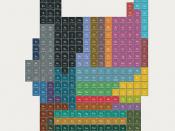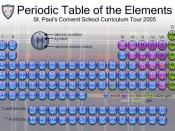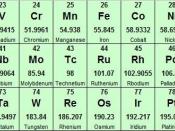Periodic Table HistoryJohn Newlands ÃÂ arranged elements by increasing atomic mass where their properties repeasted every eight element-Mendeleev arranged the elements in order of increasing atomic mass with columns with similar properties (created first periodic table)-also predicted the existence and properties of undiscovered elements & left blank spaces in the table where he thought the undiscovered elements would go-Mosley arranged the elements in order of increasing atomic number rather than increasing atomic mass and the problems with the order of the elements in the periodic table were solved-periodic law is the periodic repetition of properties of elements when they are arranged by increasing atomic number-columns are groups and rows are called period-1A-8A are the representative elements-1A elements (except for hydrogen) are known as alkali metals-2A elements are known as the alkaline earth metals-1B-8B are the transition elements-B elements divided into transition metals and inner transition metals (located at bottom of PT)-7A are the halogens and 8A are the noble gasesClassification of ElementsEach of the group 1A elements has one electron in its highest energy level (thus each element has one valence electron)-atoms in the same group have similar chemical properties because they have the same number of valence electrons-the energy level of an elementÃÂs valence electrons indicates the period on the periodic table in which it is found-gallium has a electron configuration of [Ar]4s23d104p1-valence electrons are in the fourth energy level and gallium is found in the fourth period-Because s orbitals hold a maximum of two electrons, the s-block portion of the periodic table (one all the way on the left) spans two groups-The p-block (one all the way on the right) three p orbitals can hold a maximum of six electrons spans six groups on the periodic table-the d-block (middle one) contains the transition metals ÃÂ five d orbitals...
Reviews of: "Chemistry Study Notes - The Periodic Table and What Its Classification of Elements Tells Us"
:
More Chemistry
essays:
Lab Report: determine the molar mass of an unknown gas, from the gas density
... the mass of the air in the bottle equaling .604g. Therefore the bottle itself weighed 54.7244g. Now the next step is to determine the mass of each gas. After the mass of the gas is found, we then can divide the mass by the volume of the bottle to find the correct density of the gas also. The table ...
Fossil Fuels
... vehicles - mass transit, bicycles, and walking - solar energy, nuclear energy, and hydroelectricity - improved efficiency and waste heat recovery In conclusion I don't think the need for a substitute for fossil fuels will be fully met until the demand arises. A substitute maybe found before the need ...
Expansion on the Recent Discoveries Concerning Nitric Oxide
... in the brain and other parts of the body. Nitric Oxide is not to be confused with nitrous oxide, the latter of which is commonly known as laughing gas. Nitric oxide has one more electron than the anesthetic. NO is not soluble in ...
Pheromones
... that is attractive to women. Upon application the solvent will evaporate leaving the residual perfume and the androstenone. The small amount of perfume is designed to attract women consciously while the androstenone-pheromone works in the background in the unconscious way of most pheromones. Next ...
Thallium
... element was Thallium. It is atomic number 81. It has 81 protons and electrons and 123 neutrons. Thallium has a mass of 204.3833 atomic mass units. Its symbol is Tl. It resides in Group IIIA of the periodic table. That is the ...



Study Notes
Please keep in mind when rating this that it is study notes.
0 out of 0 people found this comment useful.